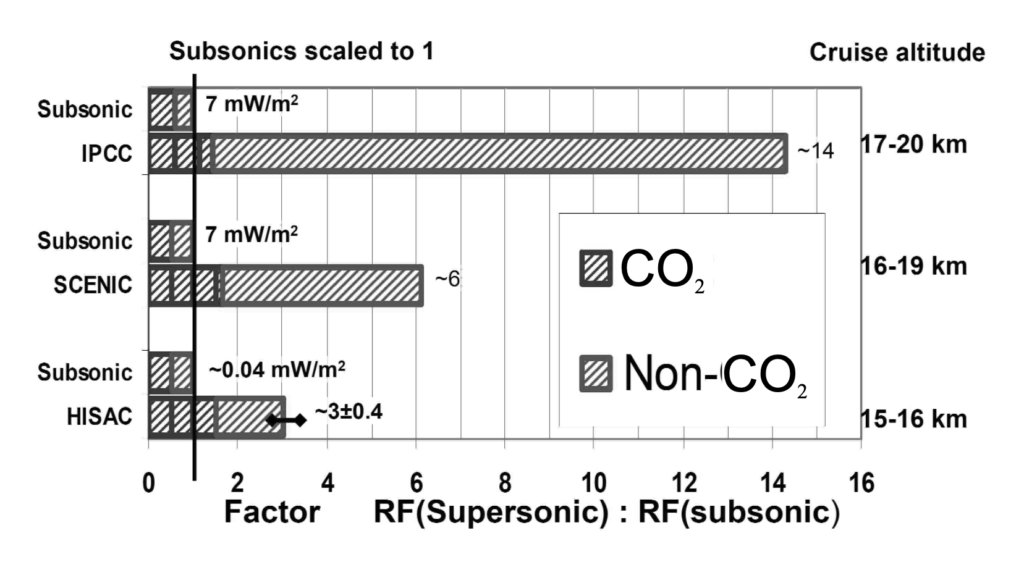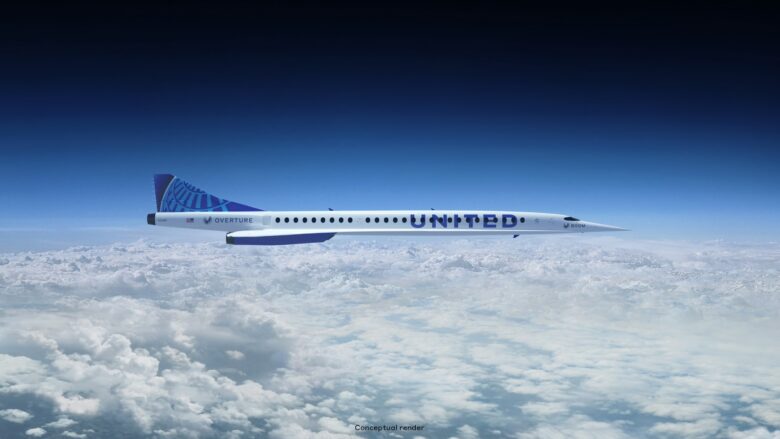Scrolling through the news media or LinkedIn, I often come across posts and claims that are sugar-coated at the best, and plain greenwashing at the worst. In my area of interest, aviation, this has primarily been from anything to do with the use of batteries in aircraft, especially from personal aerial mobility startups. Now, apparently, it’s the turn of supersonics.
Companies such as Boom Supersonic and now-defunct Aerion Supersonic have been trying to bring back supersonic commercial air travel. Especially Boom has been vocal about being “proud to ensure [supersonic travel is] environmentally friendly”, as Raymond Russel, their Head of Sustainability, put it. The company has certainly tried to convince the public that this is possible, with headlines such as “Boom announces first fully carbon-neutral aircraft program”.
If there is one thing I have learnt when it comes to sustainable aviation, it’s that these headlines should immediately be treated with some suspicion from consumers. “Carbon-neutrality” has become synonymous with “sustainability”, but the meaning of both terms is ambiguous. Without a proper definition, this ambiguity can be used to hide the actual environmental and social cost of a technology, such as supersonic aircraft. Carbon-neutrality does not mean no emissions. Aircraft are responsible for a lot more than just CO2 emissions. It is high time that the various news media and general public understand this.
Collectively, we need to improve our science communication, especially when it comes to sustainability and the climate. We need to stop using “carbon-neutral” as a catch-all term, because as we will see, being carbon neutral does not mean a certain technology is good for the climate. We also need to continue questioning what we read and see, especially when it seems too good to be true, or doesn’t seem to have any disadvantages. As one of my professors once wisely told me: There is never any free lunch.
As I show in this article, Boom (although many other companies do the same thing) is either not disclosing the full climate impact of their design, or their sustainability team hasn’t done their research properly. And to be honest, I do not know which is worse.
How sustainable are supersonics?
Various research programs over the years have analysed the environmental impact of supersonic aircraft, dating back to even before the Concorde stopped operations. I will use the IPCC, SCENIC and HISAC studies. I have included all sources at the bottom of this article in case you want to look at their results in more detail. (Note: In this analysis, I will use radiative forcing rather than a change of temperature. Of course, there is a difference between the two, but for the purposes of this analysis the former will suffice).
Combustion of kerosene (created from fossil fuels or otherwise) results in various emissions, not just CO2. In fact, for subsonic aircraft, CO2 emissions are only responsible for about a third of anthropogenic warming (Lee et al. 2021 – this is a major simplification, please see the report for more details). The other key sources of warming are water vapour and NOx emissions, as well as contrails. How does this compare to supersonics?

I have borrowed this figure from the HISAC report (Grewe et al. 2010). There are two things to note. First, the less obvious one: Generally, supersonic aircraft consume around 3 times as much fuel as subsonic aircraft and thus also have about three times the CO2 emissions, and without any numbers to the contrary we can only assume that Boom’s Overture and other new supersonic aircraft will be similar, but with the advancement of technology perhaps slightly better. Secondly, and most importantly, the non-CO2 effects dwarf the CO2 effects at high cruise altitudes. Depending on the cruise altitude and fuel consumption, supersonics have a 3 to 14 times higher climate impact than equivalent subsonics.
The atmosphere is highly non-linear, meaning that it is hard to explain exactly why this is the case. CO2 emissions are fairly easy: releasing 1 kg of CO2 in one location is approximately equivalent to releasing it at any other location in the atmosphere. This is not true for non-CO2 emissions. In this case, I would like to focus on two aspects: water vapour and NOx emissions. The stratosphere, where supersonic aircraft will be flying, is a very dry place – adding water vapour at this altitude thus has a large impact. This is also why we cannot simply power our supersonic aircraft with hydrogen (thereby removing CO2 emissions altogether), as I have seen a few people suggest. Furthermore, NOx emissions at altitude decrease the concentration of stratospheric ozone. In the stratosphere, ozone depletion is not a good thing.
Where does that leave Boom’s Overture (for example)? Without a proper analysis, it is hard to determine how this would translate to Overture, but its expected cruise altitude of 60,000 ft (just over 18 km) suggests that it will have a climate impact ratio at the higher end, maybe even somewhere close to 10. But it is not only this number that concerns me: Looking at Boom’s website and blog, I cannot find a single mention of non-CO2 emissions, only claims of improved fuel consumption and the use of sustainable aviation fuel (SAF). In reporting about Boom and other proposed supersonic designs, also nothing.
What about SAF?
Boom claims on their website that their SAF offers an 80% reduction in CO2 emissions. For a comparable subsonic aircraft, that is thus a 1/3 * 4/5 = 26% reduction in warming (again, this is a major simplification). Not nothing, but it’s not 80%. As the previous figure shows, a 26% reduction is only valid if CO2 emissions make up approximately a third of anthropogenic warming. Once non-CO2 effects take over and CO2 emissions make up only around a tenth of total warming, the actual reduction by using SAF compared to conventional kerosene is only 5-10%. And we must also remember what this “reduction” is: the aircraft in total still has many times the climate impact than an equivalent subsonic aircraft.
Carbon-neutral? No. Sustainable? No. Misleading? Absolutely.
So where does this leave us?
Don’t get me wrong: I think supersonics are super interesting. Many years ago, I remember watching the last flight of the Concorde in Bristol. It’s amazing to think that the Concorde first flew in 1969, the year my parents were born, and what an engineering marvel it was and remains to this day.
However, rich businesspeople flying across oceans supersonically just to save a few hours of travel time but whilst simultaneously warming the planet at extortionate rates is not what the world needs right now. In fact, I would call such an endeavour selfish and arrogant. Same thing goes for buying your own private jet during the pandemic to jet-set around the world because no commercial flights are available.
What we need is a set of comprehensive measures to ensure that the next generation of aircraft are as sustainable as possible, and continue to improve with time. Let us use SAF to improve current aircraft emissions. According to recent research, SAF has the potential to reduce the total climate impact of subsonic aircraft by 30 to 60% by removing CO2 lifecycle emissions and reducing contrail formation. Hydrogen turbines and fuel cells are expected to achieve up to 75% and 90% climate impact reductions. This is what we should be focusing on since these technologies will actually make a difference and make aviation more sustainable.
I sincerely hope that the regulatory bodies recognise this and prevent supersonic aircraft from ever entering the market. Not because they are not cool and interesting, but because they will do irreparable damage to our planet.
Once again, unfortunately, this is another case of just because something is possible and some rich people can afford it, does not mean we have to do or allow it.
Sources
IPCC: Special Report on Aviation and the Global Atmosphere, in: Intergovernmental Panel on Climate Change, edited by Penner, J.E., Lister, D.H., Griggs, D.J., Dokken, D.J. and McFarland, M., Cambridge University Press, New York, NY, USA, 1999
Grewe, V., Stenke, A., Ponater, M., Sausen, R., Pitari, G., Iachetti, D., Rogers, H., Dessens, O., Pyle, J., Isaksen, I., Gulstad, L., Søvde, O.A., Marizy, C. and Pascuillo, E. Climate impact of supersonic air traffic: and approach to optimize a potential future supersonic fleet – Results from the EU-project SCENIC, Atmos Chem Phys, 2007.
Grewe, V., Plohr, M., Cerino, G., Di Muzio, M., Deremaux, Y., Galerneau, M., de Saint Martin, P., Chaika, T., Hasselrot, A., Tengzelius, U., Korovkin, V.D. Estimates of the climate impact of future small-scale supersonic transport aircraft – results from the HISAC EU-project, The Aerosnautical Journal, 2010.
Lee, D.S., Fahey, D.W., Skowron, A., Allen, M.R., Burkharft, U., Chen, Q., Doherty, S.J., Freeman, S., Forster, P.M., Fuglestvedt, J., Gettelman, A., De León, R.R., Lim, L.L., Lund, M.T., Millar, R.J., Owen, B., Penner, J.E., Pitari., Prather, M.J., Sausen, R., Wilcox, L.J. The contribution of global aviation to anthropogenic climate forcing for 2000 to 2018, Atmospheric Environment, 2021.
